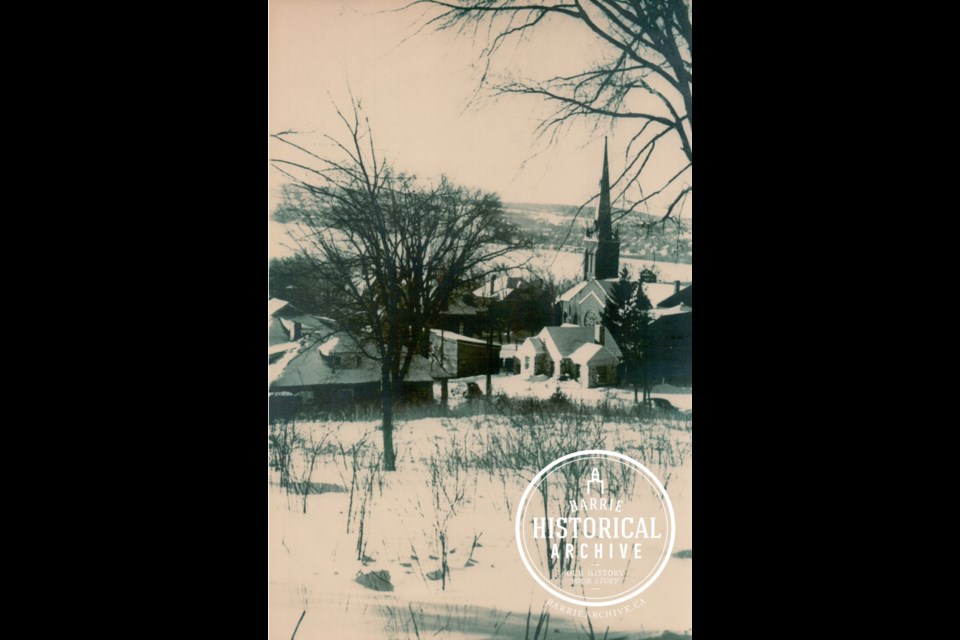This ongoing series from Barrie Historical Archive curator Deb Exel shows old photos from the collection and one from the present day, as well as the story behind them.
Looking down Poyntz Street
This little section of Poyntz Street between Collier and Worsley streets still has some similarities even 80 years after Nora Marshall photographed this scene. Collier Street church is still there, the little stone cottage is still there, but the building obscured by the tree in the foreground of the photo — that house is gone.
The piece of property to the east of the church at the corner Collier and Poyntz streets, was first owned by John Somerset in 1842.
Somerset sold the lot to William H. Cross in 1886. Cross had purchased Graham’s tannery in 1881 at a public auction, making it successful and establishing a leather store, W.H. Cross and Co., on Dunlop Street. The Sinclair brothers from Port Hope took over management of the tannery in 1883.
Barrie architect Thomas Kennedy designed Cross’s stunning, three-story Victorian mansion. Built in 1886, the house was striking from the outside with its long, stained-glass windows, exterior wall decorations and unique terracotta roof ornaments. Inside, the many mahogany fireplaces were enhanced with Italian marble and china tiles, and even more marble could be found throughout the home in the form of niches, baths and wash basins. In the glass panels of the front door were the letters ‘WHC’ on one side, and ‘IJC’ on the other. It’s assumed they were the initials of Cross and his wife. It was most definitely a spectacularly elegant home.
Dr. J.L.G. McCarthy was the next to live in the grand home located at 116 Collier St. McCarthy came to Canada from Ireland with his father, Dalton McCarthy, in 1847. Although McCarthy went back to England for his early education, he returned to Canada and attended the Barrie Grammar School before heading to the University of Toronto and graduating from the Toronto School of Medicine in 1865. He came to Barrie to practise in 1869, living and working on Collier Street. McCarthy held the rank of lieutenant-colonel of the 35th regiment, as a surgeon, and was president of the Barrie Golf Club in 1900 — a prominent citizen from a prominent family.
In 1913, George Montgomery Vance, a lawyer practising in Shelburne, was appointed to the High Court as judge of Simcoe County. The judge purchased the gracious home on Collier Street in 1915 and lived there until he died in 1927.
James Frank Wildman, a one-time school teacher originally from Pulteney, N.Y., came to Toronto in 1896 as the general manager and treasurer of Office Specialty Mfg. Co. Wildman’s first wife, Elizabeth Eleanor Vincent, died in 1903, leaving him with their three sons to raise until he was remarried in 1908 to Jennie Gray. Upon his retirement, he bought the beautiful Collier Street home in 1927. The Wildman family owned the home until it was sold to the United Church in the mid-1950s to make room for a new auditorium and expanded facilities.
As the demolition of the magnificent home drew close, much was made of the notable people who had lived there. Conspicuously absent was reference to perhaps the most important occupant of the Collier Street home: Dr. Jennie Gray Wildman.
Jane “Jennie” Gray was born Dec.15, 1862, in Dundas. She attended the Ontario Medical College for Women in Toronto in 1892, becoming a member of its consultative staff.
Gray, along with two others, established a dispensary for poor women in 1898, first at the Toronto City Mission, then relocated to the Medical College for Women. Gray, in addition to being co-director of the clinic, taught at the Ontario Medical College. It was the first clinic for women, which later evolved into Women’s College Hospital in 1911 — the only hospital in Canada that was staffed entirely by women. The hospital also provided positions for women doctors at a time when these opportunities were not often open at other institutions. Women’s College Hospital saw female patients only until into the 1920s.
Word of mouth within Toronto’s lower- to middle-class women helped to build awareness and acclaim for Women’s College Hospital. The fact the hospital provided care regardless of an individual’s circumstances — religion, finances or nationality — made it welcoming at a time when access to affordable health care or social services was not an option for many low-income families.
Records show “in 1915, Dr. Jennie Gray Wildman was president of the Toronto Women’s Medical Association, vice-president of the Canadian Purity-Education Association, and president of the Canadian Auxiliary of the Women’s Christian Medical College in Ludhiana, India, a union training college for Indian girls. From 1920-1926, Dr. Jennie Gray Wildman was chief of gynaecology at Women’s College Hospital.”
In addition, she presented her paper on prenatal care to the Women’s Medical Society of New York in Manhattan. In 1923, the hospital created the Community Clinical Association to operate community clinics in Toronto. Dr. Jennie Gray Wildman was one of the Women’s College Hospital doctors who donated her time to provide medical care to the needy and create awareness of the hospital and its programs.
Once she moved to Barrie, she was president of the Woman’s Christian Temperance Union.
In the Museum of Health Care at Kingston, there is a physician’s treatment book. These little notebooks were common in the 1800s, used by both doctors and medical students for keeping useful information or lecture notes. The notebook preserved at the museum included personal comments, financial accounts and handwritten recipes for medications. The importance of this particular book is that it belonged to one of the first generation of women doctors in Canada: Dr. Jennie Gray Wildman.



